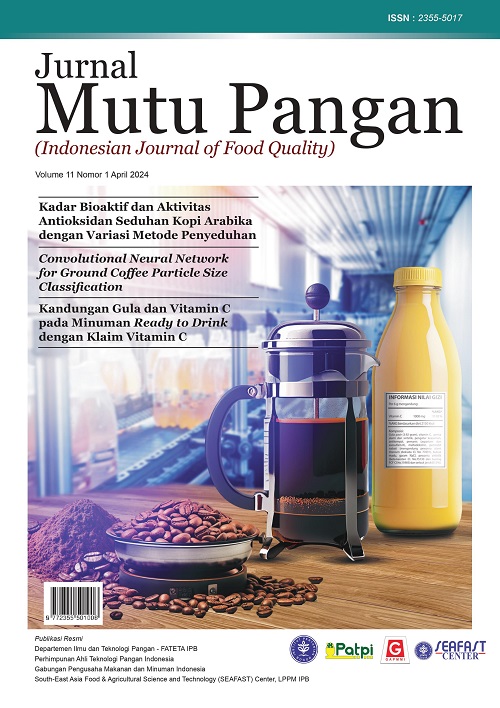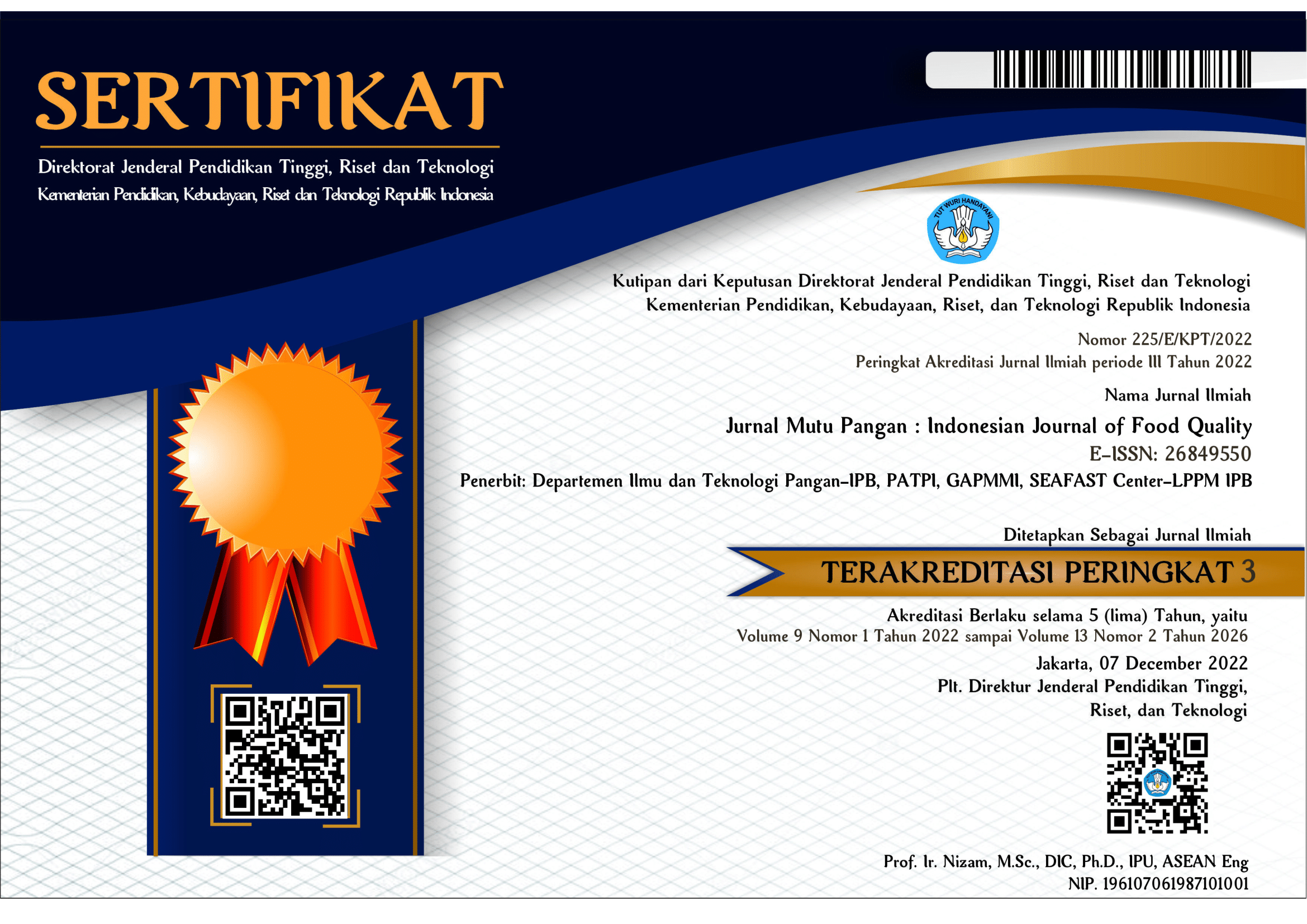Kandungan Gula dan Vitamin C pada Minuman Ready to Drink dengan Klaim Vitamin C
Abstract
Declining COVID-19 positive case does not reduce food industry, especially ready to drink (RTD) beverages industry, to sell product with vitamin C claim. Furthermore, increasing air pollution and climate change has encouraged consumers to maintain their immune system. Meanwhile, RTD beverages are well known as calorie drink with its high sugar content, hence could increase risk of type 2 diabetes. This research aims to evaluate sugar type, sweetener type, sugar and vitamin C content, and vitamin C claim which stated on the label of vitamin C claimed RTD beverages (food category 14.1.4.1 and 14.1.4.2) that is sold in various minimarket and supermarket in Bogor area, and online shop during February to May 2023. Total sugar content subsequently compared to front of pack (FoP) labelling guidance from United Kingdom (UK), Singapore, and Indonesia. This research has collected 70 samples, that consists of fruit juice drink, fruit flavored drink, fruit drink, tea drink, jelly drink, carbonated flavored drink, and milk flavored drink. As much as 74.28% among the samples contained sugar, mainly from sucrose, above 6 g/100 mL. Besides sugar, 52.74% samples contained sweetener, with stevia as natural sweetener more used than artificial sweetener. Based on sugar FoP labelling guidance, the majority of samples was in medium (amber) category in UK, C (orange) category in Singapore, and orange category in Indonesia. Source of vitamin C was the most claim stated as nutritional content claim, while vitamin C function claim to help collagen formation and maintenance was more mentioned compared to immunity claim.
Downloads
References
Adawiyah DR, Puspitasari D, Lince L. 2020. Profil sensori deskriptif produk pemanis tunggal dan campuran. J Teknol Industri Pangan 31(1): 9–20. DOI: 10.6066/jtip.2020.31.1.9.
Aina Q, Ferdiana S, Rahayu FC. 2019. Penggunaan daun stevia sebagai pemanis dalam pembuatan sirup empon-empon. J Scientech Res Dev 1 (1): 1-11. DOI: 10.56670/jsrd.v1i1.1.
Atmaja AT, Astawan M, Palupi NS. 2017. Kesesuaian komposisi gizi dan klaim kandungan gizi pada produk MP-ASI bubuk instan dan biskuit. Penelitian Gizi Makanan 40(2): 77–86.
Atmarita, Jahari AB, Sudikno S, Soekatri M. 2016. Asupan gula, garam, dan lemak di Indonesia: Analisis survei konsumsi makanan individu (SKMI) 2014. Gizi Indon 39(1): 1-14. DOI: 10.36457/gizindo.v39i1.201.
Baharuddin, Suhartati, Permana SV, Rumpa FA, Hanum PS. 2020. Fructose effects on blood glucose and uric acid levels. Asian Jr of Microbiol Biotech Env Sc 22(1): 200–205.
[BPOM] Badan Pengawas Obat dan Makanan Republik Indonesia. 2023. Peraturan Badan Pengawas Obat dan Makanan Nomor 13 Tahun 2023 tentang Kategori Pangan. Jakarta: BPOM RI.
[BPOM] Badan Pengawas Obat dan Makanan Republik Indonesia. 2022. Peraturan BPOM RI Nomor 1 Tahun 2022 Tentang Pengawasan Klaim Pada Label Dan Iklan Pangan. Jakarta: BPOM RI.
[BPOM] Badan Pengawas Obat dan Makanan Republik Indonesia. 2021. Peraturan Badan Pengawas Obat Dan Makanan Republik Indonesia Nomor 20 Tahun 2021 Tentang Perubahan atas Peraturan Badan Pengawas Obat dan Makanan Nomor 31 Tahun 2018 tentang Label Pangan Olahan.
[BPOM] Badan Pengawas Obat dan Makanan Republik Indonesia. 2019. Perka BPOM No. 11 Tahun 2019 Tentang Batas Maksimum Penggunaan Bahan Tambahan Pangan. Jakarta: BPOM RI.
[BPOM] Badan Pengawas Obat dan Makanan Republik Indonesia. 2016. Perka BPOM No. 9 Tahun 2016 Tentang Acuan Label Gizi. Jakarta: BPOM RI.
Choi J, Kim D-Y, Choue R, Lim H. 2017. Effects of vitamin C supplementation on plasma and urinary vitamin C concentration in Korean Women. Clin Nutr Res 6(3): 198-205. DOI: 10.7762/cnr.2017.6.3.198.
Cianconi P, Betrò S, Janiri L. 2020. The impact of climate change on mental health: A systematic descriptive review. Front Psychiatry 11(74): 1-15. DOI: 10.3389/ fpsyt.2020.00074.
Debras C, Chazelas E, Srour B, Druesne-Pecollo N, Esseddik Y, de Edelenyi FS, Agaësse C, De Sa A, Lutchia R, Gigandet S, Huybrechts I, Julia C, Kesse-Guyot E, Allès B, Andreeva VA, Galan P, Hercberg S, Deschasaux-Tanguy M, Touvier M. 2022. Artifi-cial sweeteners and cancer risk: Results from the NutriNet-Santé population-based cohort study. PLoS Med 19(3): 1–20. DOI: 10.1371/journal.pmed.10039 50.
Devolli A, Stafasani M, Shahinasi E, Dara F, Hamiti H. 2021. Determination of vitamin C content in commercial fruit juices by volumetric and spectrophotometric methods. J Hyg Eng Des 34: 124–131.
DiNicolantonio JJ, Lucan SC. 2015. Is fructose mal-absorption a cause of irritable bowel syndrome? Med Hypotheses 85: 295-297. DOI: 10.1016/j.mehy. 2015.05.019.
Fadlillah H, Ramadhan HS, Hermanianto J, Felanesa L. 2020. Study on sweetener selection in RTD tea beverages. J Teknol Industri Pangan 31(1): 1–8. DOI: 10.6066/jtip.2020.31.1.1.
Fadlillah HN, Nurkhoeriyati T, Felanesa L, Utomo AW. 2019. Study on functional ingredients and claims of ready to drink (RTD) fruit juice in modern retail. J. Funct Food Nutraceutical 1(1): 13–22. DOI: 10.33555/jffn.v1i1.5.
[FSA] Food Standards Agency. 2016. Guide to creating a front of pack (FoP) nutrition label for pre-packed products sold through retail outlets. Department of Health, the Food Standards Agency, and devolved administrations in Scotland, Northern Ireland and Wales in collaboration with the British Retail Consortium.
Gombart A, Pierre A, Maggini S. 2021. Editorial: A review of micronutrients and the immune system—Working in harmony to reduce the risk of infection. Nutrients 236(12): 1–41. DOI: 10.3390/nu13114180.
González C, Tapia M, Pérez E, Pallet D, Dornier M. 2014. Main properties of steviol glycosides and their potential in the food industry: A review. Fruits 69(2): 127–141. DOI: 10.1051/fruits/2014003.
Hambali ML. 2022. The Urgency of sugar sweetened beverages excise policy: A literature study for implementation in Indonesia. BISNIS BIROKRASI J Ilmu Adm Organ 29(1): DOI: 10.20476/jbb.v29i1.1325.
Hannou SA, Haslam DE, McKeown NM, Herman MA. 2018. Fructose metabolism and metabolic disease. J Clin Invest 128(2): 545–555. DOI: 10.1172/JCI96702.
Hasanah U, Adawiyah DR, Nurtama B. 2014. Preferensi dan ambang deteksi rasa manis dan pahit: Pendekatan multikultural dan gender. J Mutu Pangan 1(1): 1–8.
[HPB] Health Promotion Board Singapore. 2023. Measures for Nutri Grades. https://hpb.gov.sg/healthy-living/food-beverage/nutri-grade [25 Feb 2023].
Ikrima IR, Giriwono PE, Rahayu WP. 2023. Pemahaman dan Penerimaan label gizi front of pack produk snack oleh siswa SMA di Depok. J Mutu Pangan 10(1): 42–53. DOI: 10.29244/jmpi.2023.10.1.42.
Imoisili O, Park S, Lundeen EA, Pan L, O’Toole T, Siegel KR, Blanck HM. 2020. Sugar-sweetened beverage intake among adults, by residence in metropolitan and nonmetropolitan counties in 12 states and the district of Columbia, 2017. Prev Chronic Dis 17(E07): 1–7. DOI: 10.5888/pcd17.190108.
Indriani F, Sodik MA, Yudhana A. 2023. Healthier choice logo (bpom) education on knowledge and selection of processed food products for public health iik strada student’s. J Hosp Manag Serv 5(1): 17–22.
Julianto A, Mulyani S, Wartini NM. 2021. Pengaruh persentase penambahan bubuk daun stevia rebaudiana bertoni dan lama penyeduhan terhadap karakteristik minuman kunyit asam. J Rekayasa Manajemen Industri 9(2): 174-185. DOI: 10.24843/JRMA.2021.v09.i02.p03.
[Kemenkes] Kementerian Kesehatan Republik Indonesia. 2019. Peraturan Menteri Kesehatan Republik Indonesia Nomor 28 tahun 2019 tentang Angka Kecukupan Gizi yang dianjurkan untuk Masyarakat Indonesia. Jakarta: Kemenkes RI.
[Kemenkes] Kementerian Kesehatan Republik Indonesia. 2018. Hasil Utama Riskesdas 2018. Jakarta: Kemenkes RI.
Li H, Cai M, Li H, Qian ZM, Stamatakis K, Mc Millin SE, Zhang Z, Hu Q, Lin H. 2022. Is dietary intake of antioxidant vitamin associated with reduced adverse effects of air pollution on diabetes? Findings from a large cohort study. Exoticol Environ Saf 246: 114182. DOI: 10.1016/j.ecoenv.2022.114182.
Li Y, Xu L, Shan Z, Teng W, Han C. 2019. Association between air pollution and type 2 diabetes: An updated review of the literature. Ther Adv Endocrinol Metab 10: 1-15. DOI: 10.1177/2042018819897046.
More TA, Shaikh Z, Ali A. 2021. Artificial sweeteners and their health implications: A Review. Biosci Biotechnol Res Asia 18(2): 227–237. DOI: 10.13005/bbra/2910.
Mustikaningrum RG, Rosalina AI. 2021. Pandangan publik terhadap klaim manfaat dan keamanan minu-man mengandung kolagen dan l-glutathione berdasarkan iklan produk. J Al-Azhar Indonesia Seri Sains Teknol 6(2): 82-89. DOI: 10.36722/sst.v6i2.724.
Narayani KB, Triloka NMK, Rianti EDD. 2022. Tingkat pengetahuan masyarakat mengenai konsumsi vitamin C dan D guna meningkatkan sistem imunitas di masa pandemi covid-19. Biosapphire J Biol Divers 1(2): 42–52. DOI: 10.31537/biosapphire.v1i2.687.
Owczarzy A, Kurasiński R, Kulig K, Rogóż W, Szkudlarek A, Maciążek-Jurczyk M. 2020. Collagen-structure, properties, and application. Eng Biomater 156: 17-23. DOI: 10.34821/eng.biomat.156.2020.17-23.
Pries AM, Mulder A, Badham J, Sweet L, Yuen K, Zehner E. 2021. Sugar content and nutrient content claims of growing-up milks in Indonesia. Matern Child Nutr 17(4): 1–11. DOI: 10.1111/mcn.13186.
Rahman VR, Bratadireja MA, Saptarini NM. 2021. Artikel review: Potensi kolagen sebagai bahan aktif sediaan farmasi. Majalah Farmasetika 6(3): 253-286. DOI: 10.24198/mfarmasetika.v6i3.33621.
Ren J, Liang J, Wang J, Yin B, Zhang F, Li X, Zhu S, Tian H, Cui Q, Song J, Liu G, Ling W, Ma Y. 2022. Vascular benefits of vitamin C supplementation against fine particulate air pollution in healthy adults: A double-blind randomised crossover trial. Eco-Toxicol Environ Saf 241: 113735. DOI: 10.1016/j.ecoenv.2022.113735.
Rønnow HN. 2020. The effect of front-of-pack nutritional labels and back-of-pack tables on dietary quality. Nutrients 12(6): 1704. DOI: 10.3390/nu12061704.
[SATGAS COVID] Satuan Tugas Penanganan COVID-19. 2023. Analisis Data COVID-19 Indonesia: Update Per 05 Maret 2023. https://covid19.go.id [16 Agustus 2023].
Sigala DM, Hieronimus B, Medici V, Lee V, Nunez M V, Bremer AA, Cox CL, Price CA, Benyam Y, Chaudhari AJ, Abdelhafez Y, McGahan JP, Goran MI, Sirlin CB, Pacini G, Tura A, Keim NL, Havel PJ, Stanhope KL. 2021. Consuming sucrose-or HFCS-sweetened beverages increases hepatic lipid and decreases insulin sensitivity in adults. J Clin Endo-crinol Metab 106(11): 3248–3264. DOI: 10.1210/clinem/dgab508.
Silva PD, Cruz R, Casal S. 2021. Sugars and artificial sweeteners in soft drinks: A decade of evolution in Portugal. Food Control 120(2021): 107481. DOI: 10.1016/j.foodcont.2020.107481.
Soplestuny ZS, Susanto A, Santoso J. 2021. Gambaran tingkat pengetahuan tentang pemanfaatan vitamin C untuk meningkatkan imunitas tubuh pada warga di Kelurahan Panggung. Parapemikir Ilmiah Farmasi x(9): 1–5.
Superindo. 2023. Panduan Indikator Kandungan Gula. https://www.superindo.co.id/korporasi-keberlanjutan/indikator-kandungan-gula [12 Juli 2023].
Syarifah M, Nurjanah D, Atikah N, Syarif A. 2022. Deconstruction of Women’s Beauty Standard on Social Media: An Analysis. Proceeding Int. Conf. Relig. Sci. Educ. 1727–733.
Szu Y, Ya L, Chi M, Yi N, Hoang K, Kee H, Chen C. 2023. Effects of oral collagen for skin anti-aging: A systematic review and meta-analysis. Nutrients 15(9): 2080. DOI: 10.3390/nu15092080.
Tseng T-S, Lin W-T, Gonzalez G V, Kao Y-H, Chen L-S, Lin H-Y. 2021. Sugar intake from sweetened beverages and diabetes: A narrative review. World J Diabetes 12(9): 1530–1538. DOI: 10.4239/wjd.v12.i9.1530.
Uddin MS, Millat MS, Baral PK, Ferdous M, Uddin MG, Sarwar MS, Islam MS. 2021. The protective role of vitamin C in the management of COVID-19: A Review. J Egypt Public Health Assoc 96(2021): 1–8. DOI: 10.1186/s42506-021-00095-w.
Wachyuni SS, Wiweka K. 2020. The changes in food consumption behaviour: A rapid observational study of COVID-19 pandemic. Int. J Manag Innov Entrep Res 6(2): 77–87. DOI: 10.18510/ijmier.2020.628.
Yang CS, Ford P, Liu X, Leishman S, Schubert L. 2016. Ready-to-drink non-alcoholic beverages: Nutritional composition and erosive potential. Nutr Food Sci 46(3): 396–411. DOI: 10.1108/NFS-09-2015-0117.

















